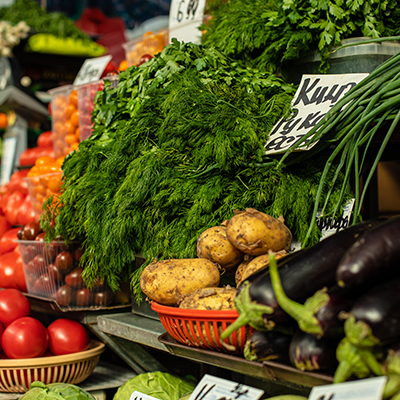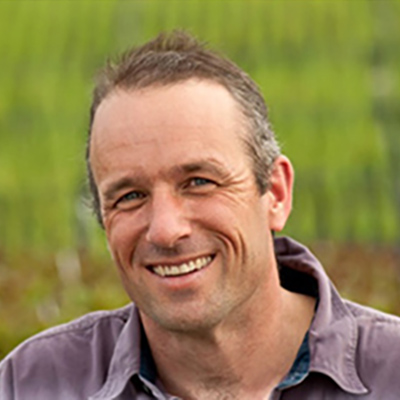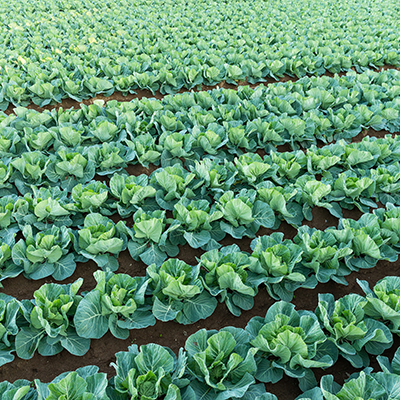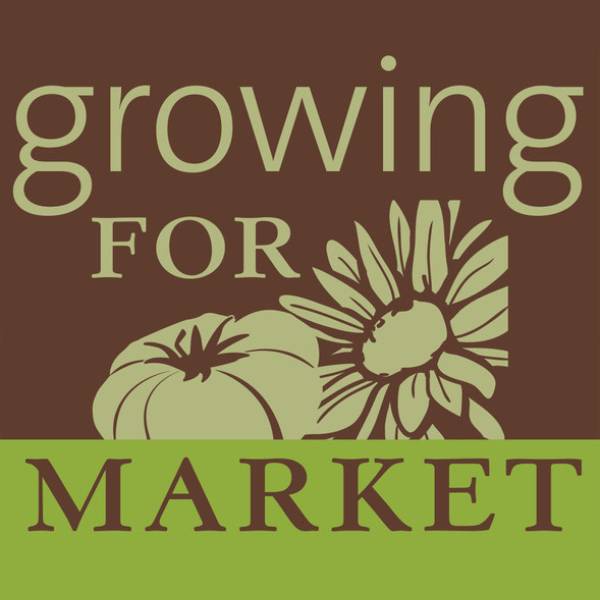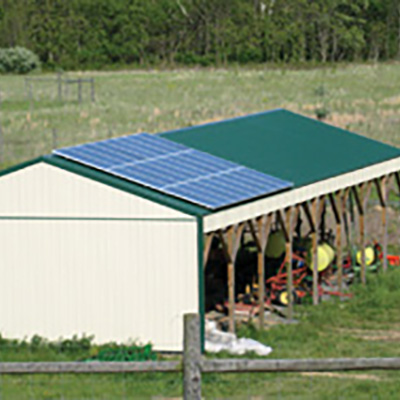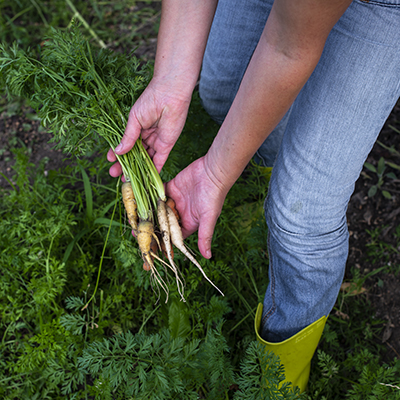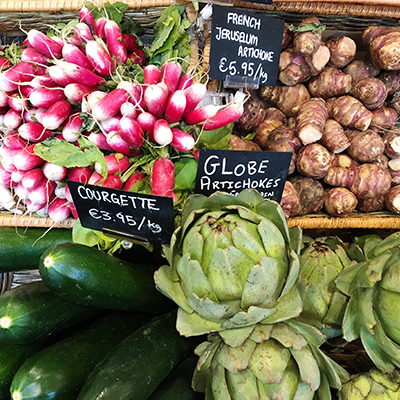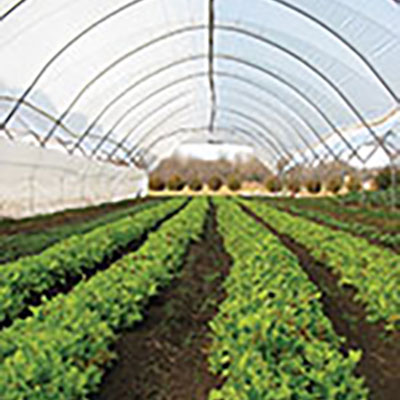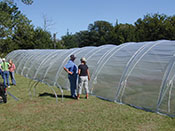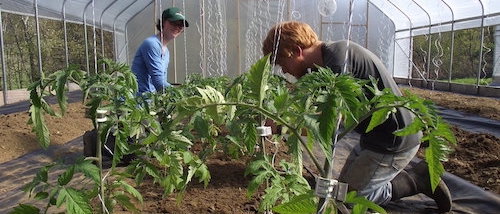By Elizabeth Henderson
and Jack Bradigan Spula
If we hadn't broken my crystal ball, we would be reading in it about the added record keeping that lies in our future as vegetable and fruit farmers. That's if we are lucky, stick together and can build solid support from our customers and all the members of the public who are excited about family-scale local farms. If not, some of us may decide to close shop.
Good Agricultural Practices (GAPS) - that sounds innocent enough. The danger lurks in who defines them and whether the rules and regulations fit farms of various sizes and processing on differing scales. Ignorance about microorganisms is so generously spread amongst the public at large that it is easy for people to panic and out of fear vote for legislation or regulations that sound safe, though may actually increase the spread of pathogens and make life a dreary round of form filling for farmers. Many shoppers, attracted by the convenience of bagged salad greens, reason that the bag provides a barrier to contamination. In fact, just the opposite is true. As Wild Farm Alliance (WFA) director Jo Ann Baumgartner told conferees at the November 2008 "Food Safety War on Wildlife Teach-In," "the bag itself is a micro-incubator: many cut leaf surfaces increase areas of infection, and the washing of thousands of pounds of greens at a time can spread pathogens to scores of consumers."
In the fall of 2008, the Food and Drug Administration (FDA) posted a notice requesting public comment on its "Guide to Minimize Microbial Food Safety Hazards for Fresh Fruits and Vegetables," including "possible measures that FDA could implement that would enhance the safety of fresh produce." If we do not pay close attention, public alarm over bagged greens and contaminated peanut butter could lead to mandatory regulations aimed at sanitizing our farms.
A little history
In the fall of 2006 several deaths and many illnesses were traced to California spinach contaminated with E. coli 0157:H7. Primarily associated with beef cows that are raised on grain instead of grass and confined for months to feedlots before they are slaughtered, E. coli 0157:H7 can also be transported by feral pigs, water or wind and show up on crops. The Community Alliance with Family Farmers (CAFF) analyzed FDA data from 1999 - 2006 and found that there were 12 outbreaks of E.coli 0157:H7 traced to California leafy greens resulting in 539 reported illnesses. Of those 12 outbreaks, 10 were from fresh-cut, processed and bagged leafy greens and those 10 outbreaks accounted for 531 of the illnesses. In the 2006 outbreak, the spinach was grown on a farm that was in transition to organic production, on land leased from a cattle ranch. Upon investigation, it was found that the irrigation water used on the spinach had the bacteria, cattle manure from the nearby ranch had the bacteria, and so did feral pig feces found a mile away from the fields. Did federal or state regulators take steps to clean up the beef operation or to clamp down on the fresh-cut system to eliminate the bacteria? You know the answer. Instead, the packers who buy and ship the bagged greens devised the "California Leafy Green Marketing Agreement" (LGMA), a 50-page set of "voluntary" regulations that growers would have to meet if they wanted to sell to the packers. Additionally, individual shippers and buyers have established supermetrics that go beyond the LGMA that encourage farmers to poison and fence out wildlife, and put in up to 450 feet of sterile ground buffers between crops and habitat. As Steve Gilman puts it in the latest issue of The Natural Farmer, "from an ecological perspective, let alone an organic farming one, the GAPS matrix outlined in the handlers' 2007 Marketing Agreement was an environmental disaster." (www.nofa.org) UC Davis researchers have shown that grasses and wetlands can filter up to 99% of pathogens from water.
A PowerPoint put together by WFA (www.wildfarmalliance.org) presents images that are reminiscent of Stalag 13: high-tech fencing and ground-level barriers, closely spaced "rodent bait/trap stations" atop berms at the edges of cultivated fields, and instances of outright removal of tree lines, hedgerows, and farm ponds. Remarkably, there is no evidence that frogs or deer vector the E.coli. In a few states, 1 - 2% of deer have tested positive for pathogenic E.coli, but since these numbers are so small, removing habitat that protects water quality is unwise. When it comes to soiling the soil, wildlife can't remotely compete with domesticated herds housed in the ag-equivalent of concentration camps. Yet even some highly respected consumer organizations are beating the drums for imposing the LGMA on all produce farmers whether they sell millions of pounds of bagged salad mixes or a few hundred heads of lettuce at a farmers market stand.
Back in the 1990s, after an earlier wave of food borne illnesses, the Cornell Cooperative Extension began offering training materials for farmers and farmworkers teaching sensible farm safety practices. The National GAPS Program is currently based at Cornell and the www.GAPS.cornell.edu website offers a guide to writing your own farm safety plan and a DVD for worker training. USDA added grading to the Cornell guidelines, turning them into a certification system. Some state departments of agriculture are conducting GAPS audits under USDA accreditation. Most states also allow private third party verification programs that can be very expensive. While these programs are all still "voluntary," some wholesalers and retail chains are requiring GAPS certification for farms that want to sell to them, as are school lunch programs.
The recent peanut butter fiasco is attracting public attention to the totally inadequate and uncoordinated hodgepodge of federal regulations. USDA and FDA both have jurisdiction over various aspects of food safety, yet neither agency has authority to require recalls of tainted product. The number of inspectors and inspections is pitiful, leaving industry to regulate itself. In a fever to do something, legislators are proposing new laws; some would set up traceability schemes, others address the structure of FDA and USDA in more or less prescriptive terms. Tune in later this spring when a top runner emerges.
To the rescue comes the Leafy Greens Working Group, a loose coalition headed by NOFA and MOFGA, including farming organizations down the East Coast, the Virginia Biological Farmers Association, Carolina Farm Stewardship and Florida Organic Growers. The National Organic Coalition (NOC) and the National Sustainable Agriculture Coalition (NSAC) are lending their networks to this effort. The Leafy Greeners agree that small-scale farms must take the bull by the horns and address the food safety issue actively and publicly. MOFGA has contracted with Jim Ostergard, well-known food safety expert, to design a do-it-yourself guide to creating your own plan for your farm based on Hazard Analysis Critical Control Point (HACCP) principles. Prospects look good for combining safety inspections with the audits that certified organic farms already undergo. At the same time, the Leafy Greeners are planning a campaign to ensure that any federal regulations that are passed will be scale and product appropriate, based on genuine risks and solid science. They are doing a literature review to see what research has been done and what is missing. On the West Coast, the Community Alliance with Family Farmers (CAFF) has created a set of GAPS for small and medium-sized fruit and vegetable growers that includes a section on the relative risks of animal presence and conservation concerns. Please stay tuned for action alerts!
A pro-active response
As market farmers, if we do not want harsh regulations imposed on us, we must demonstrate to the public that we have the situation well in hand.
What can we do on our own farms to ensure the safety of our products? Common sense will give us most of the answers.
Field preparation
Do not use fresh manure to fertilize soils where you plan to grow vegetables or herbs that touch the soil or that can be reached by splashing. Organic standards require that 120 days separate incorporation of manures from the planting of such crops. There is a lot of research that shows that a living soil with a diversity of microorganisms reduces the likelihood that pathogens from manures will survive incorporation in the soil. Thorough composting of manures will eliminate most pathogens, though careless composting will not. Allow 12 months to go by before using land that has been grazed for growing leafy vegetables.
Irrigation
Test irrigation water for coliform bacteria. Deep well water is likely to be safer than surface water, ponds or streams. If farms upstream from you are using pesticides, herbicides and chemical fertilizers, chances are good that the water will be polluted by those materials. If there is a feed lot or Confined Animal Feeding Operation (CAFO) upstream, you should probably dig a well. City or village water may be chlorinated.
Picking and packing
Make sure that everyone involved in picking and packing is trained in food safety procedures. Use clean harvesting equipment - knives, mechanical devices and containers. Harvesters should have clean hands and should not pick, wash or pack produce if they have contagious illnesses. After eating, smoking, blowing their noses or going to the bathroom, harvesters should wash their hands carefully and dry them well and the bathroom should be kept clean.
Keep the wash up area clean and use potable water for washing produce and for cleaning the surfaces in the packing shed that come in contact with the produce. NYS regulations require regular testing of wash water for coliform bacteria. Hydrogen peroxide, vinegar or peroxyacetic acid (PAA) are alternatives to chlorine. Organic standards allow the use of chlorine as long as "residual chlorine levels in the water do not exceed the maximum residual disinfectant limit under the Safe Drinking Water Act" (205.605). The standards do not specify how much chlorine to put in the wash water, only what can remain after washing. Keep in mind that the pH of chlorine used for sanitation purposes must be carefully controlled since it is ineffective if the pH is too low or too high. Exposure to organic materials also reduces the effectiveness of chlorine, which can combine with organic matter to form toxic compounds such as trichloromethane. Personally, I do not think we should use chlorine in our packing sheds.
Communication
If your farm is certified organic, let your customers know that certification restricts the use of fresh manure, and requires potable water for washing produce and an audit trail that makes it possible to trace each head of lettuce back to the bed where it was grown. If fear of paperwork has kept you from certifying, this may be the moment to reconsider or to develop a paper trail of your own that documents your care with the produce you sell. Certified or not, tell your customers about your safety practices and enlist their support in fending off excess regulation.
While making sure our farms are not incubators for pathogens, we should take every occasion to suggest a broader, more integrated understanding of food safety beyond microbial contamination. A safe food system includes considerations of food quality, nutrition and freshness, the risk of hunger, the safety of the people who work in the food system, and the health of the environment. Fresh, local food provides health insurance, instead of medical insurance. Truly safe food:
·builds body health and strengthens the immune system
·is produced non-destructively, without poisoning soil, water or air
·provides safe and fairly paid work for producers all along the food chain from the field to the table
·and is accessible to all people at a price they can afford to pay.
Jack Bradigan Spula, a lifelong resident of New York State and the Eastern Great Lakes bioregion, is a Rochester-based environmental and agricultural writer, poet, musician and activist.
Elizabeth Henderson farms at Peacework Farm in Wayne County, NY, producing food for the Genesee Valley Organic CSA, in its 21st year in 2009. She is the author of Sharing the Harvest: A Citizen's Guide to Community Supported Agriculture (Chelsea Green, 2007)
Food Safety: Let's work on this together!
By Elizabeth Henderson and Jack Bradigan Spula
April 1, 2009

